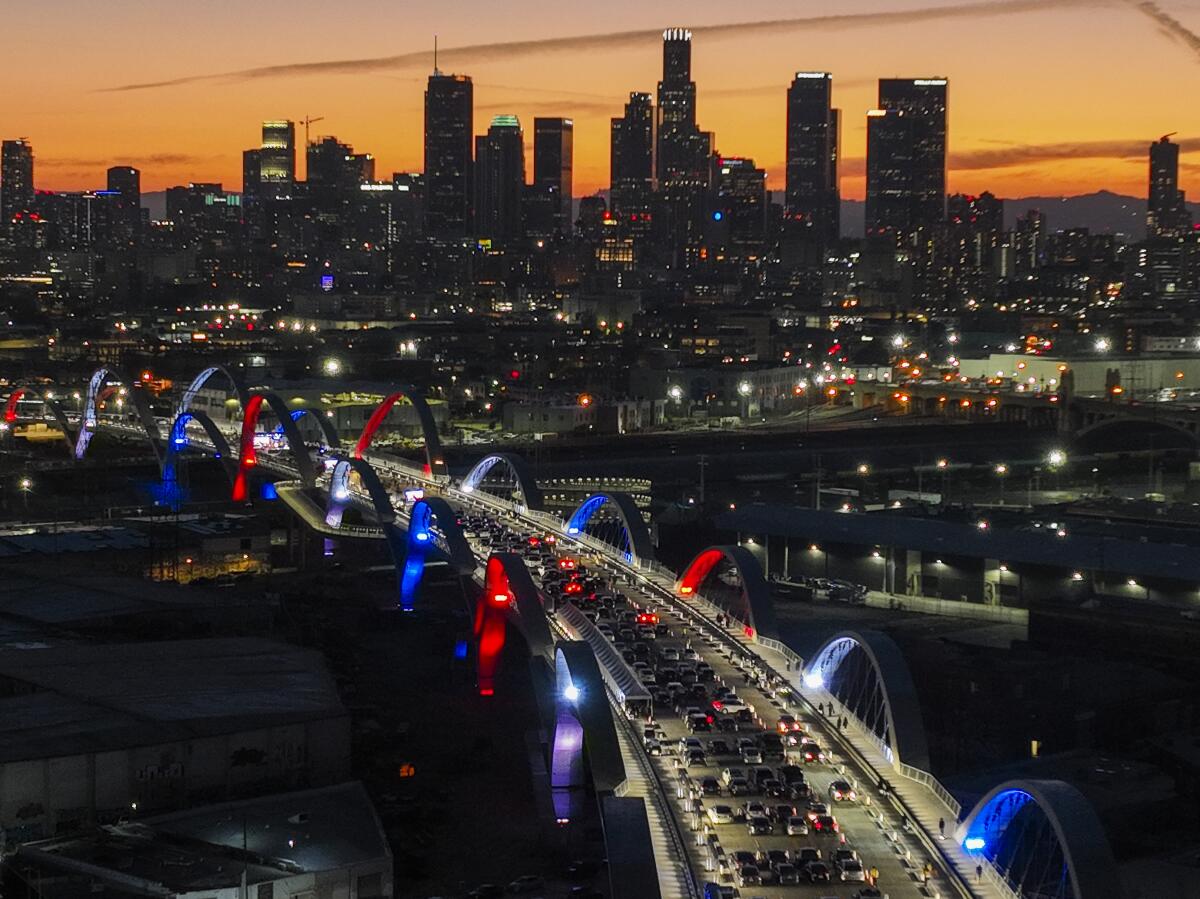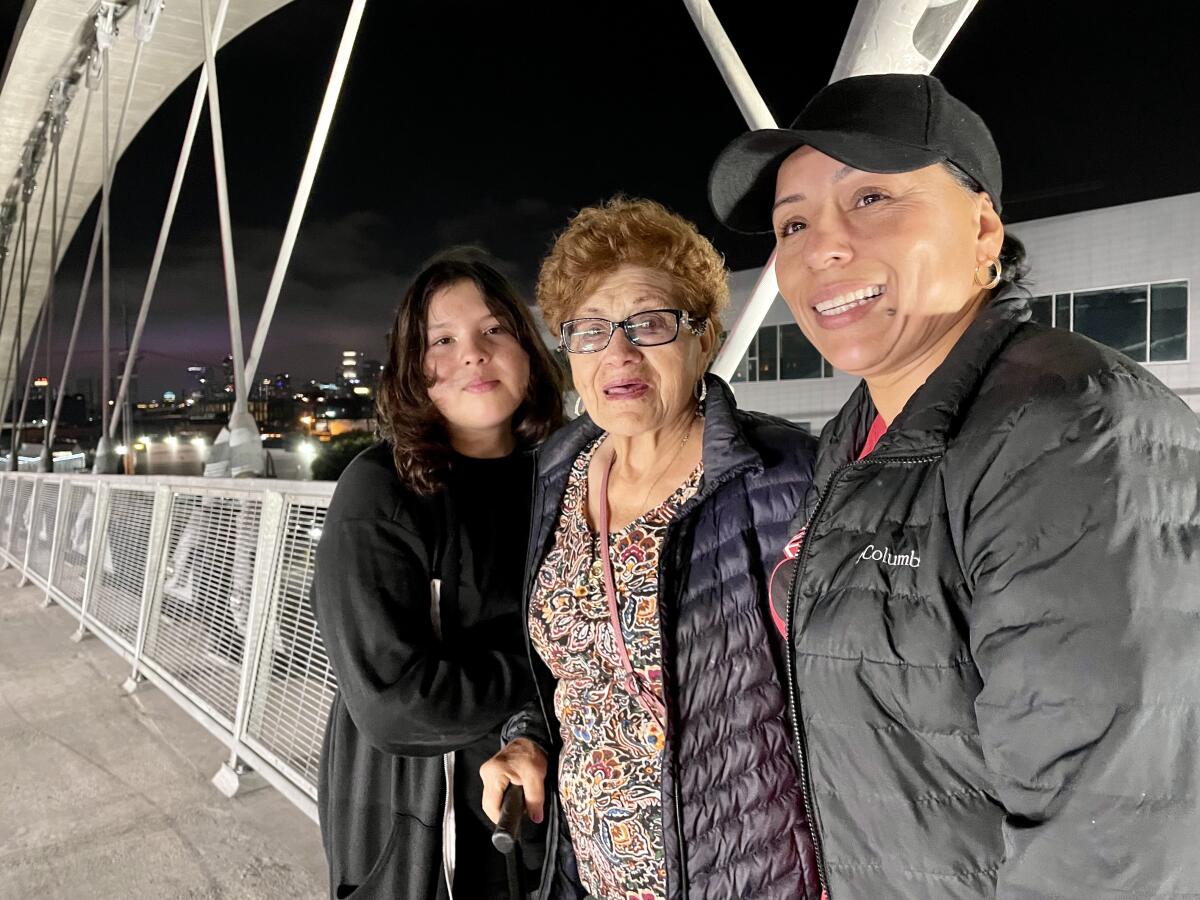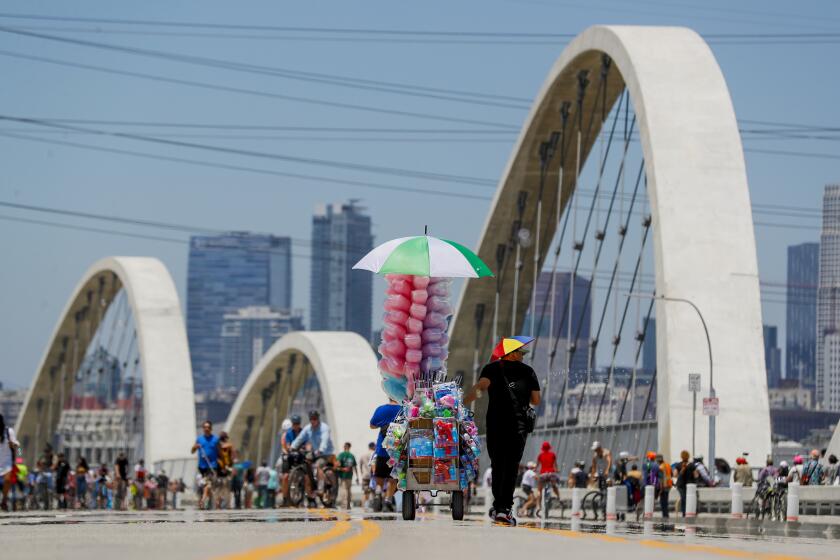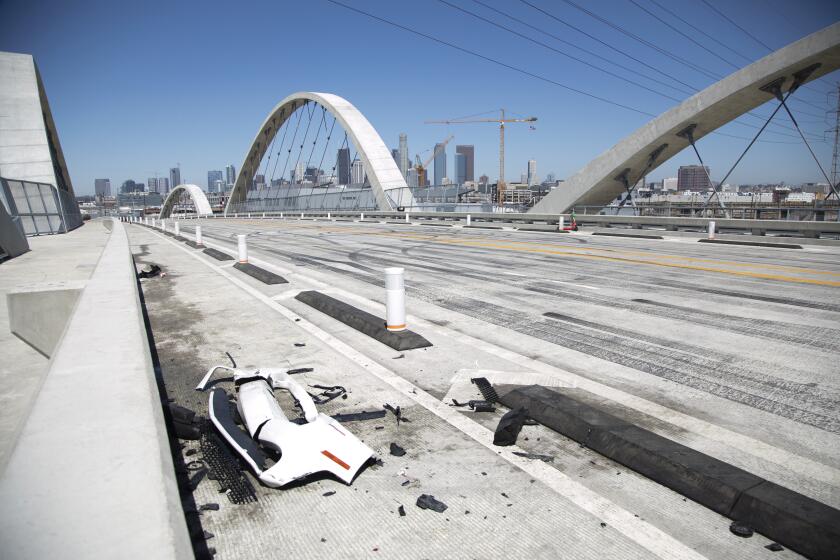Column: 6th Street bridge is an instant L.A. icon — if drivers don’t ruin it for everyone else

- Share via
Gus Ugalde grew up loving the 6th Street bridge, so much so that when the aging structure was demolished in 2016, it broke his heart.
Ugalde had fond memories of riding his bike onto the bridge and holding his grandmother’s hand as they traversed the L.A. River from their home in Boyle Heights, headed to the big city. The dazzling skyline beckoned, and the bridge was a link to possibility, opportunity and the world beyond.
“I can still hear the sound of my corduroy pants rubbing against each other like that of clothes being scrubbed on an old-fashioned washboard. It was perpetual summer. I could still see grandma holding her parasol overhead to shield herself from the unyielding rays of the sun,” Ugalde wrote in an essay for a class I taught at Cal State Los Angeles.
She rode her bike across the bridge at night and saw children playing in the street and kids on scooters, enjoying the bridge as a community resource.
He was in his 50s at the time, had written for community newspapers and was one of my most senior students. When the new 6th Street Viaduct was about to open this month, I thought of Ugalde. I recalled him telling me that he couldn’t wait to walk across it with his daughter Jewel, holding her hand as he had held his grandmother’s.
Unfortunately, that day will have to wait. When I reached out to Ugalde, he told me he’s recovering from a ruptured Achilles tendon.
Ugalde also said he was upset to see that while some celebrated the long-awaited opening of the new bridge, others created an ugly scene with tagging, stunt driving and accidents. The knucklehead convention got so bad, the bridge — which cost nearly $600 million and took several years to build — was closed three nights in a row over the weekend.
“I imagine my grandmother’s reaction … would be much like my own. I think it’s disgusting how these people have taken over the bridge just to satisfy their self-centered needs,” Ugalde said.
His grandmother, Josefina Duran, “would have been one of the first to walk its length,” Ugalde said. “What’s not to love about it? I am hoping, as I know my grandmother would, that this outrageous behavior will end quickly. It somewhat surprises me that the city and the LAPD got caught off guard by this. I guess looking at things in hindsight is much easier, but these nightly activities are no surprise to me.”
I visited the bridge around midday Monday and then again after dark. After the three-night shutdown, the bridge reopened and the scene was relatively calm. Except for some young rebels gunning their engines or stopping in the middle of the roadway to admire their surroundings or take a selfie, as if no one and nothing else in the world mattered.
It is a little surprising that the bridge’s multiple arches are so easy to scale and either jump or fall off of. I also wondered why the bike lanes don’t have more protection and separation from vehicles, especially given the scary skid marks cars have already burned.
LAPD Chief Michel Moore said Tuesday that speed bumps, a center median and fencing might be installed to prevent speeding, accidents and the climbing of the arches.
Given the popularity of street takeovers across the region, and the use of local bridges for suicide attempts, they should have thought of that sooner. There also should be a discussion, sooner rather than later, about closing the bridge to vehicles at least a couple days a week.
But on Monday night, the negatives were overshadowed by the positives. Children, adults, families, walkers and bike riders made the bridge their own.

“I love it,” said Bert Lira, who walked from his home in Boyle Heights across to the Arts District before turning around with his dog King, a Husky. “It’s relaxing. You’ve got bike lanes; it’s meditative.”
Lira was upset about the earlier mayhem, saying “people are crazy. They’ve got their cars and they want to show off.” But he thinks far more people will be inclined to respect the bridge as a social and architectural landmark.
“I think it’s beautiful,” said Gabriel Garcia, who ran a hot dog stand at the western end of the bridge and had a simple explanation as to why a few people spoiled the fun and forced the temporary shutdown: “Some people are stupid.”
But he also noted the procession of families across the span and predicted the bridge will be a popular workout course for runners, cyclists and walkers.
Dominique Bouquet and her sister Alyssa were on their way home to Fullerton after a trip to Las Vegas and the San Fernando Valley and decided they had to stop to see the bridge.
“We did see someone flip a U-turn really hard, and it was a little scary,” said Dominique, but they liked the bridge and the festival vibe on a comfortable, cool summer night.
“I was very proud the first couple of days,” said Yolie Acosta, though she wondered whether the bridge should have opened before potential security issues were addressed.
Who knew a four-lane roadway with no signals and unprotected bike lanes would attract dangerous drivers?
Acosta, of Boyle Heights, walked with her daughter, Pahtli, and assisted her mother-in-law, Socorro Flores, who used a cane but had nearly made it all the way across the bridge. Acosta said that as much as she loves the bridge, she was considering a couple of design tweaks.
Maybe the lighting is too harsh and can be toned down, she said. And it might have helped to use spikes or something on the arches to discourage climbers.
“But I’m very excited,” Acosta said as jumbo jets swam across the sky like airborne sharks, looping into their LAX approach. The bridge may be the star attraction, but the view from it is not bad either, Flores said, as she gazed into the constellation of skyline lights. “You can see L.A., you can see Dodger Stadium, City Hall.”
Although walking the bridge is out of the question for Ugalde as he recovers from his injury, my former student — a library assistant in Victorville — told me he has driven across the span with Jewel, who’s now 9, and son Stevie, 4.
“I was just telling my wife that it’s already an L.A. landmark, and part of history,” said Ugalde, who told me he particularly likes the view of the span from the 4th Street bridge.
Ugalde said his grandmother grew up in a Jalisco river town, “so she adopted the L.A. River in a small way” when she moved here. He recalled her stopping when they crossed the old 6th Street bridge to point out local landmarks.
Just like he’ll do with his daughter and son when they walk across the new bridge for the first time.
More to Read
Sign up for Essential California
The most important California stories and recommendations in your inbox every morning.
You may occasionally receive promotional content from the Los Angeles Times.













